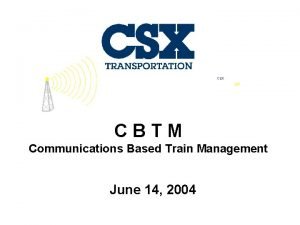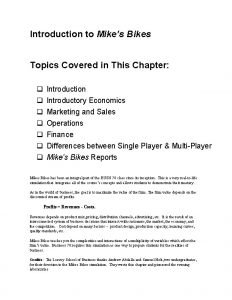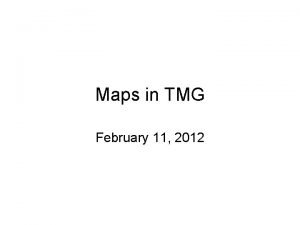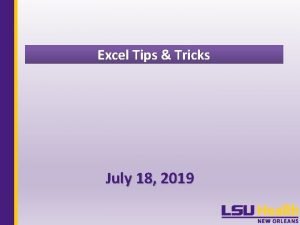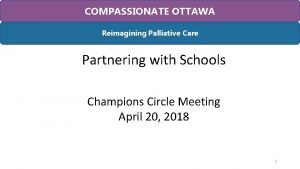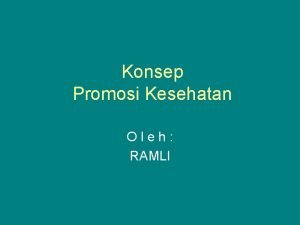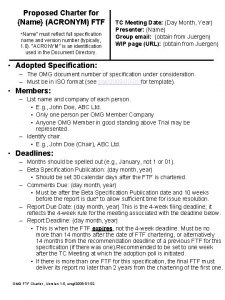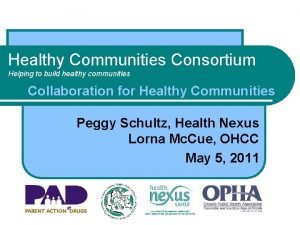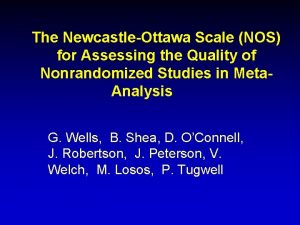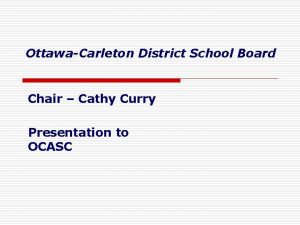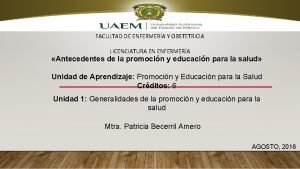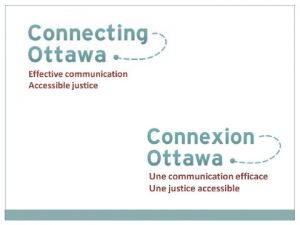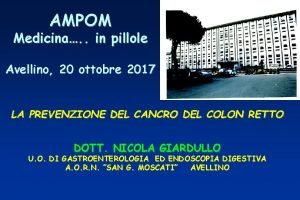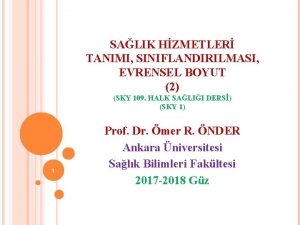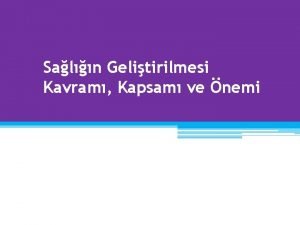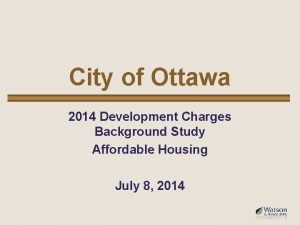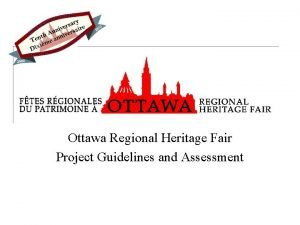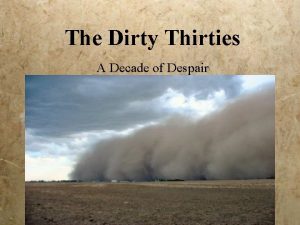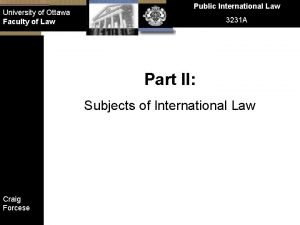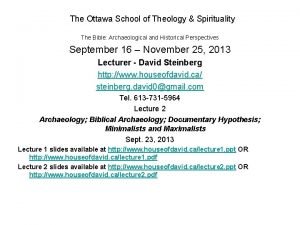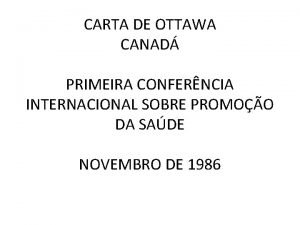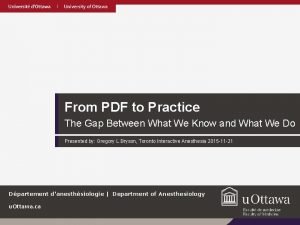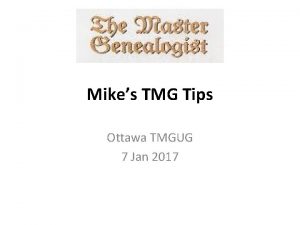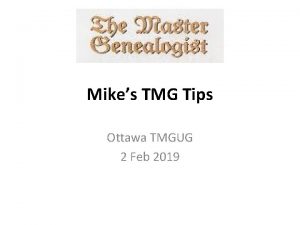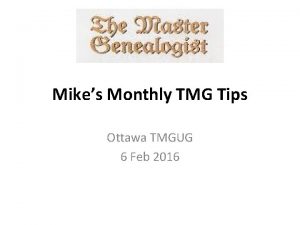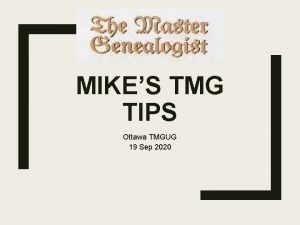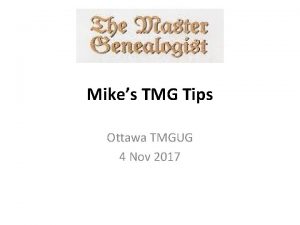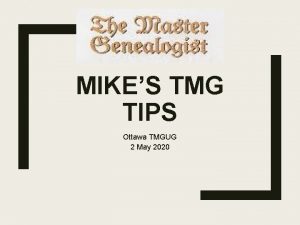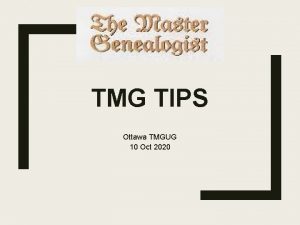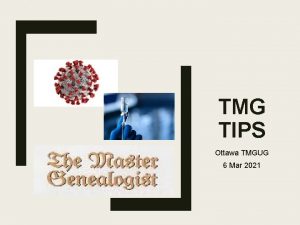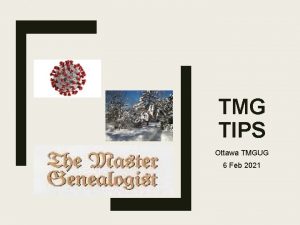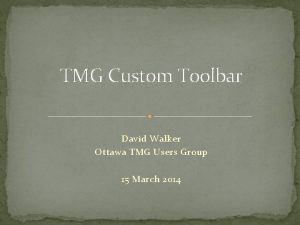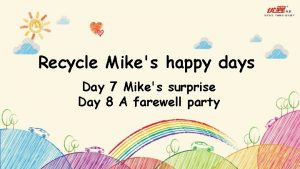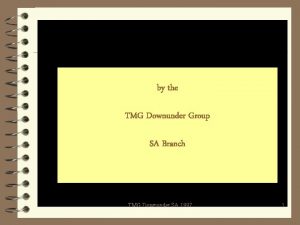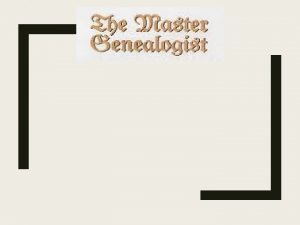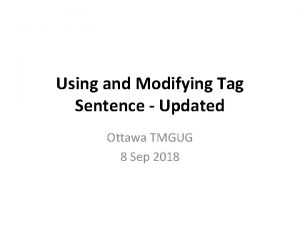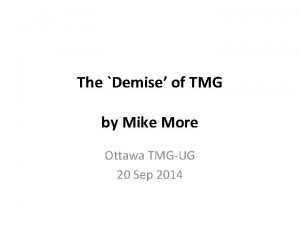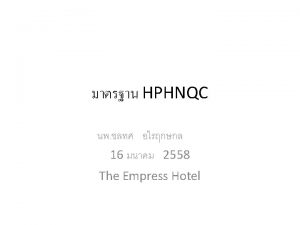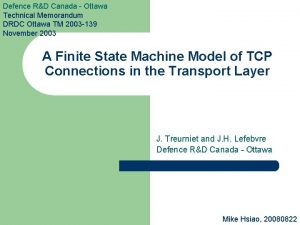Mikes TMG Tips Ottawa TMGUG 5 Jan 2019





















![Memo Zero The variable [M 0] refers to the "zeroth" segment of the Memo Memo Zero The variable [M 0] refers to the "zeroth" segment of the Memo](https://slidetodoc.com/presentation_image_h/d6bd1a5d170857fc6454efd576530a1e/image-22.jpg)











- Slides: 33

Mike’s TMG Tips Ottawa TMGUG 5 Jan 2019

History Research Environment (HRE) History Research Environment is a community project to create a free platform-independent application for the serious amateur or professional historical researcher. For genealogists, HRE will provide an onward path for users of the discontinued program The Master Genealogist (TMG). HRE will also handle a very wide range of other historical and cultural research needs. Project website: https: //historyresearchenvironment. org Volunteer skills: https: //historyresearchenvironment. org/become -a-volunteer/ Donate: https: //historyresearchenvironment. org/donate/ Wiki: http: //hrewiki. org/index. php? title=Main_Page

HRE newsletter, July 2018 • At the end of April, locked down the design of the HRE database – that is, the design of all the database tables and how they all link together. • The development team have put together the first real screens of ‘HRE v 0. 1’ and are starting to flesh out the code behind them.

Social Media Update TMG-REFUGEES: https: //lists. rootsweb. ancestry. com/hyperkitty/list/tmgrefugees@rootsweb. com/ Website: https: //sites. google. com/site/tmgrefugees -Seems to have gone silent; very little activity TMG Facebook Page: Four posts in December plus several replies https: //www. facebook. com/groups/themastergenealogist/ TMG Mailing List https: //lists. rootsweb. ancestry. com/hyperkitty/list/tmg@rootsweb. com/ -29 threads in December and still very active Wholly Genes Forum http: //www. whollygenes. com/forums 201/index. php -7 discussions in December

TMG Expertise • Terry Reigel: http: //www. reigelridge. com • Lee Hoffmann: http: //www. tmgtips. com/ • John Cardinal: https: //www. johncardinal. com/ • Michael Hannah: – https: //www. mjh-nm. net/MY_WAY. HTML • Jim Byram

Maintenance • Last month we had discussion about using the TMG Maintenance Function: – Reindex – Optimize – Validate File Integrity • VFI, Optimize and Reindex work on the WHOLE database, not just one project.

Maintenance process Some people run VFI multiple times until it reports no errors. As far as I can tell, there's no value to running Optimize between VFI steps, so this sequence seems ideal: Optimize VFI (repeat until no errors) Optimize The first Optimize recreates the indexes and removes deleted records. This provides a good base for the VFI(s). The VFI step repairs data integrity issues. Fixing one issue can expose another, and that's why running it multiple times is useful/required. The second Optimize rebuilds the indexes and removes deleted records. Any changes as a result of this step are due to VFI activity. The final Optimize will always show a difference because of the nature of what Validate does. That difference is not an error or a problem, it is simply a measure of the "clean up" Optimize did. -John Cardinal

Maintenance process 1. 2. Jim Byram recommends finishing with Reindex but John Cardinal did some testing years ago and determined that Optimize recreated all the indexes from scratch, whereas Reindex recreated the contents of the indexes, but not the index structure definitions. So, a corruption in an index header field would not be corrected by Reindex. “Furthermore, I am not aware of any case where using Reindex solved an issue that Optimize did not solve. ” It was also thought that the intermediate Optimize step would remove deleted data so that the next VFI would not scan that data. John Cardinal: “It's very, very unlikely that the VFI step processes deleted records. Undeleting deleted records and assessing them during the VFI process would introduce issues that are impractical to resolve without AI that we don't have yet. I suppose the only harm is wasted time. I have 89, 000 individuals/124, 000 names in my project and Re. Index took one minute; Optimize 2’ 18” and VFI was 18 Minutes

Relationships The easiest way to get a list of your second cousins (or any other relationship is to generate a Kinship Report. Set the Subject of the report to your ID# (or that of the person for whom you want the relationships). In the [Options. . . ] window=>General tab, select the Ancestors and Cousins options and set the number of generations to the desired number. You would use 2 for first cousins, 3 for second cousins, 4 for third, etc. The report gives all relationships within that number of generations. Be warned that if you have a large project and set the number of generations to the default (250), then the report may take some time to generate!! But you get an interesting report to look at.

Kinship Report



Suppress details for living people If this option is chosen then all name and event tags (except the primary name) are suppressed for people for whom LIVING=Y or ? is set. They are replaced with a single sentence: [P] "is still living. " You can change this sentence in an option below. Living text The text used when Suppress details for living people is checked can be changed. For example, instead of "is still living" you might want to say "is still alive. "

Living People in Gedcoms & Reports 1. TMG does not consider the Name of a person to be a 'detail', so that is not removed by the "Suppress Details of Living People" option. 2. TMG determines 'living' solely on the state of the 'Living' flag. Make sure the people who have details that shouldn't be included don't have this flag set to N. 3. Make sure you use the output of THAT export, and not one that was created with different settings. -Richard Damon


Project Problem My observation over many years is that the most common cause is some program working in the background on the TMG files while TMG is running. While the most common such programs are automatic backups, especially the intrusive Windows One. Drive, virus checking programs can also be monitoring TMG files and cause problems. Are you really, really sure that there are no such programs? There are known problems with the TMG program itself, including its underlying Visual Fox Pro, and serious issues may require removing TMG and reinstalling a clean version. If you do wish to do that, follow Jim's instructions posted on the Wholly Genes Forum. It is the second post in the pinned topic about the TMG Final Installers: http: //www. whollygenes. com/forums 201/index. php? /topic/15915 -tmg 9 -finalinstallers-v 905/ - Michael J. Hannah

VFI Log The Last VFI. log can give you a lot of information. You can also get in idea or the areas in which the Validate File Integrity (VFI) function spends more time by watching the notices in the upper right corner of the screen, Keep in mind that there are more of some records than others. For example, there are usually more event record (Tags) than names, so when that is being checked, it takes longer than say people records. The size of your project affects how long a VFI run takes -- both the overall size as well as the sizes and number of data sets. A project of less than 1, 000 persons will normally have a VFI run of about 10 to 20 seconds. A project of around 60, 000 persons will take over five minutes. In both these cases, this is with no problems found. Where problem are found and corrected, the time will be longer although that probably will not be more than a few added seconds. Again, analysis of the Last. VFI. log can tell where those problem were. In almost all cases, the problems that VFI finds and fixes are more of an administrative nature so your data is not really affected. Find it under > The Master Genealogist v 9 > Projects > Last VFI. log

VFI Log 18: 43: 49 >Start 18: 43: 49 >c: UsersOwnerDocumentsThe Master Genealogist v 9ProjectsMore__. PJC 18: 43: 51 >2% Creating list of folders 18: 43: 51 >3% Searching Exhibits files 18: 43: 52 >399 external exhibit files were checked. 18: 43: 54 >2% Checking tags. . . 18: 43: 54 > fixed 0 18: 43: 54 >5% Checking primary markers. . . 18: 43: 55 >8% Checking last viewed spouse. . . 18: 44: 58 > fixed 4 18: 45: 01 >9% Checking name sorting. . . 18: 45: 01 >12% Checking name sorting. . . 18: 45: 02 >13% Checking name sorting. . . 18: 49: 01 >25% Checking names - unused records. . . 18: 49: 02 > fixed 0 18: 51: 42 >36% Auditing event surety values. . . 18: 56: 37 > recreated 18: 56: 37 >37% Auditing relationship surety values. . . 18: 52 > recreated 18: 52 >38% Auditing name surety values. . . 19: 01: 29 > recreated 19: 01: 30 >42% Checking history tag sentences. . . 19: 01: 30 > fixed 0 19: 01: 30 >43% Checking flags. . . 19: 01: 30 > fixed 0 19: 01: 31 >65% Sorting. . . 19: 01: 31 >90% Checking witnesses. . . 19: 01: 36 > fixed 0 19: 01: 37 > fixed (WDL) 0 19: 01: 49 >100% FINISHED

Moving to New Computer Terry Reigel has a set of instructions here: https: //tmg. reigelridge. com/new-computer-version. htm Be sure you are using your TMG 9 serial number, and the name and email address as shown in your registration email. If you did not save your registration e-mail, all is not lost: Click on Help > Technical Support >Trouble Report - open in word processor and save for future reference Just the top part needs to be saved, since there no longer is Technical Support at Wholly Genes

Repeated Requests for Unlock Code 1. When asked for the unlock code, do not enter it but instead close TMG. 2. Right-click on the desktop shortcut for TMG, and choose "Run as Administrator" and enter your administrator password if one is in use for your system. 3. When TMG opens and you are prompted for the unlock code, enter it and the name and e-mail address you used when you purchased the current version of TMG. 4. Close TMG, and then re-open normally. You should not be asked for the unlock code again. This procedure only works after you have been prompted to enter the unlock code, including the very first time you open TMG after installing it on a system. Using it when you have not been prompted for the unlock code does not work.

Technical Details When you are prompted for the unlock code, TMG writes it into the Windows registry. It tries to write it into a part of the registry where programs are not normally allowed to write while the program is open. Windows intercepts this attempt, and instead directs the entry into an area called "Virtual. Store, " where it functions normally. However, Windows periodically clears the Virtual. Store thus removing the unlock code. The next time you open TMG you are asked for it again. When you use the "run as administrator" method described above Windows does allow writing of the unlock code into the restricted area, where it is permanently stored. -Terry Reigel
![Memo Zero The variable M 0 refers to the zeroth segment of the Memo Memo Zero The variable [M 0] refers to the "zeroth" segment of the Memo](https://slidetodoc.com/presentation_image_h/d6bd1a5d170857fc6454efd576530a1e/image-22.jpg)
Memo Zero The variable [M 0] refers to the "zeroth" segment of the Memo field. That segment does not exist. It is used only when you choose the Report Option to put "Memos that are not included in the sentence" in footnotes, endnotes, or embedded. By specifying <[M 0]> in the Sentence, there is a Memo variable in the Sentence, one that produces no output, so any other Memo contents for this Tag are not placed in footnotes, endnotes, or embedded. Thus you can specify that most memos not called by a Memo Variable are output to footnotes, endnotes, or embedded, but those for specific Tags are not. [M 0] written, without conditional brackets, always returns "(an unknown value)' in the sentence preview and any report that uses Sentences, like Narrative reports. Always enter it as <[M 0]> to avoid the "unknown value" output. If you don't use the Report Option, the <[M 0]> variable has no effect at all. -Terry Reigel

Accents on the Picklist The 'Expanded Picklist' is accented, the 'Simple Picklist' is not. Not to be confused with the Project Explorer window. Choose: Preferences > Lists

Accents on the Picklist

Accents on the Picklist

Numbers vs Roman Numerals I have two data sets going but one uses numbers for the sources and the other is using Roman numerals. I suspect you are encountering a known remaining bug in TMG reports. I suspect that the report which shows Roman numerals has its Report Options set as: • Memos tab - Embedded option, *AND* • Sources tab - Endnotes, Unique not checked See my description of this bug and its workaround in my on-line list of remaining TMG bugs: https: //www. mjh-nm. net/BUGS. HTML#B 38 You need to either change one of those Report Options, or later change the footnote numbering of that report in Word. -Michael J. Hannah

Exhibits The big difference between internal and external exhibit is that internal exhibits are stored in the database itself, while external exhibits are stored ‘externally’, and only a link to the exhibit is stored in the database. While it is true that internal exhibits have the seemingly advantage that they are automatically backed up when you back up your data, this is actually one of their biggest disadvantage. This means that every time you backup your data you MUST also backup all your exhibits, even though there may be no changes in them, and they make your backups much larger because of that, so you tend to backup less often. With External Exhibits you can choose to include the exhibits in the backup, or leave them out at times to save space and time. I have long since removed all my internal exhibits and made them external. Second Site can not handle internal image exhibits, so they need to be converted to be external to publish with it.

Exhibits Is there a "batch" way to convert all internal exhibits to external? And is there a "best" place to store external exhibits? TMGU by John Cardinal has a batch extraction routine. I place them in a folder parallel to my TMG Files, i. e. C: GenealogyExhibits - Richard Damon

No Known Children I want to suppress the No Known Children output in Journal reports for a few specific persons only, without modifying the report definition. This happens when I do have information about the children of some couple, but since it is not a line I want to follow any further, I have not (and probably will not) add the persons to the dataset. Instead, I put the information in the Marriage Note field and that's all I am going to say about them. The report, being blind to my notes, is going to say they don't exist. • You can suppress the statement using a Narrative. Children tag. See: ttps: //tmg. reigelridge. com/Narrative. Children. htm

Customizing the “Children of” Statement (https: //tmg. reigelridge. com/Narrative. Children. htm) TMG's Journal reports include a list of the children of the focus person, which is introduced with statement similar to: Children of John Jones and Mary White were as follows: If there are no children of the couple in the Data Set, a statement like this appears: There were no children of John Jones and Mary White. There are several report options to modify these statements, which apply to everyone in the report. When a Narrative. Children Tag is created for a couple, the output of that tag is substituted for the standard "Children of. . . " statement in Journal Reports. Both parents (or spouses) must be entered in the tag as Principals. If a person has multiple spouses, a separate Narrative. Children tag must be created for each couple for whom you want a custom "Children of. . . " statement.

Genealogy: Back To Basics A basic level genealogy lecture followed by a Q&A session. Next: 26 Jan: Genealogy Drop-In: volunteers will be here to answer questions & help you get the most from resources. Bring your laptop or tablet! There is no charge for the sessions and all are invited to return at 1: 00 pm for the monthly presentation. Coffee and tea will be available. Following session: 23 Feb: Getting Started by Mike More For more topics, check our website at http: //ogsottawa. on. ca/.

Genealogy Drop-In Drop in to get some help on your family tree, share research strategies, & discover what resources are available for your research. Experienced researchers from Ottawa Branch will be here to answer questions & help you get the most from several resources. Bring your laptop, or tablet! Sessions are free and open to all. Ottawa Public Library Genealogy Drop-In: - Tuesday 08 Jan at 2: 00 pm, Nepean Centrepointe - Tuesday 22 Jan at 2: 00 pm, Nepean Centrepointe - Tuesday 05 Feb at 2: 00 pm, Nepean Centrepointe - Tuesday 19 Feb at 2: 00 pm, Nepean Centrepointe Ottawa Public Library Genealogy Research Lab: - Thursday 31 Jan at 7: 00 pm, Nepean Centrepointe - Thursday 28 Feb at 7: 00 pm, Nepean Centrepointe Ottawa Branch OGS Genealogy Drop-In: - Saturday 26 Jan at 10: 30 am, City of Ottawa Archives Coffee and tea will be available throughout the morning

GENE-O-RAMA 2019 presented by Ottawa Branch OGS April 5 -6, 2019 Confederation Education Centre 1645 Woodroffe Avenue, Ottawa Speakers, Marketplace, Research Room Featured Speaker: Glenn Wright Leanna Cooper, Ron Dale, Sadie De Finney, Shirley-Ann Pyefinch, Lisa Tremblay-Goodyer, Mary Munk, Megan Butcher, Ken Mc. Kinlay Volunteers Needed Details and registration when available: https: //ottawa. ogs. on. ca/geneorama/
 Cns10 mikes
Cns10 mikes Mikes bikes simulation single player
Mikes bikes simulation single player Elle.tmg
Elle.tmg Tmg feeds
Tmg feeds Tmg copyright
Tmg copyright Tmg macro
Tmg macro Excel tips and tricks 2019
Excel tips and tricks 2019 Compassionate ottawa
Compassionate ottawa Misi promosi kesehatan
Misi promosi kesehatan Ftf acronym
Ftf acronym Ottawa in north america map
Ottawa in north america map Ottawa charter
Ottawa charter Newcastle-ottawa scale template
Newcastle-ottawa scale template Cathy curry ottawa
Cathy curry ottawa Carta de ottawa mapa conceptual
Carta de ottawa mapa conceptual Connecting ottawa
Connecting ottawa Ottawa bowel preparation scale
Ottawa bowel preparation scale Environnement canada ottawa
Environnement canada ottawa Ottawa bildirgesi
Ottawa bildirgesi Jakarta bildirgesi
Jakarta bildirgesi City of ottawa development charges
City of ottawa development charges Issa ottawa
Issa ottawa Heritage fair ideas
Heritage fair ideas Ottawa rozloha
Ottawa rozloha Health promotion strategies
Health promotion strategies Thedirty ottawa
Thedirty ottawa Carta de ottawa de 1986
Carta de ottawa de 1986 Ottawa suzuki strings
Ottawa suzuki strings Zona continua
Zona continua Ruang lingkup promkes
Ruang lingkup promkes Ottawa school of theology and spirituality
Ottawa school of theology and spirituality Pdhpe ottawa charter
Pdhpe ottawa charter Declaração de ottawa
Declaração de ottawa Endo guys ottawa
Endo guys ottawa
